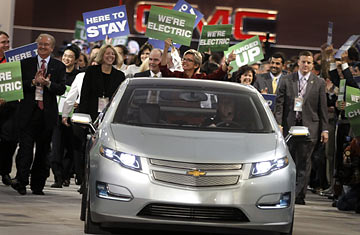
Michigan Governor Jennifer Granholm, center, and others march behind a Chevy Volt electric car during the Detroit International Auto Show in Detroit
No place has felt the pain of General Motors' collapse quite as completely as Flint, Mich., which is about an hour's drive north of Detroit. Back in the early 1970s, GM had as many as 80,000 employees around Flint, making it one of the premier company towns in the U.S. But as GM's fortunes have fallen, so have those of Flint. GM is still the largest employer in town by far, but its Flint payroll has dropped to fewer than 8,000. Meanwhile, the Genesee County Land Bank owns more than 4,000 vacant residential properties in and around Flint, which had 124,000 residents at the last census. Today, streets are mostly abandoned, the average value of a single-family home has dropped to $16,400 and the city's unemployment rate hovers at 27%, which is two points better than it was in August when it hit 29%.
Flint's new mayor, Dayne Walling, says the city is proud of its historical connection to GM. But it is looking for ways to diversify its economic base, revive the downtown areas and bring down the crime rate, which also has blighted the community's reputation. "We have some major challenges," he says.
Thus, GM's $230 million investment in four factories around Flint, to prepare for the start of production for the innovative Chevrolet Volt, represents an important ray of hope for the hard-pressed Flint community. "These four GM manufacturing plants have a key role in GM's production of the next generation of fuel-efficient vehicles, the Chevrolet Volt and Cruze," says Larry Zahner, GM manufacturing manager.
"There was a lot of uncertainty as we went through the bankruptcy," notes James Scrimger, an employee in GM's Flint Die Center, which is one of the locations in Flint where GM is spending money on the Volt and other projects. The Flint Die Center, for example, has also been assigned a role in the new GM, building tools for GM's stamping plants. "Thing are starting to look up," adds another employee at the center.
Most of the GM money — $202 million — is being spent at the company's Flint South engine plant, which is being renovated for production of a 1.4-liter, four-cylinder engine generator for the Chevrolet Volt and a 1.4-liter, turbocharged, four-cylinder engine for the 2011 Chevrolet Cruze. The project will bring an additional 240 employees to the Flint plant. Almost all of the added staff will come from the Flint North engine and component plant that GM plans to close next year.
The Volt is scheduled to start production in late 2010 as GM's first extended-range electric vehicle, which can travel up to 40 miles on electricity from a single battery charge, while the Flint-built engine will serve as a backup generator that extends the car's range to about 300 miles.
Duane Zuckschwerdt, UAW Region 1C director and a member of the union's top executive board, readily acknowledges that Flint is often held up as a symbol of crippling labor-management strife, but he sees the Volt investment as a significant milestone for the city. "I know you go just 50 miles west of here and they think the town is dead," Zuckschwerdt says. "But it's not. GM knows they have a very talented workforce here," he says.
GM built the Flint South plant only 10 years ago, but rows of empty lockers inside the plant's washroom offer silent testimony to the changes around the giant automaker, which emerged from bankruptcy in July thanks to a $50 billion infusion of cash from the U.S. Treasury Department and is counting on the Volt to help restore the company's reputation.
Technological change, for better or worse, has been a fact of life around Flint, Zuckschwerdt says. When he was hired at GM more than 40 years ago, the old engine plant that once stood next door employed more than 4,000 workers building V8 engines, Zuckschwerdt says. When the new Volt line starts production next year, the Flint South plant, which also makes V6s used in various GM vehicles, will have the same capacity as the old V8-engine plant. It will also produce machined block heads and crankshafts. But it will have fewer than 600 production employees. "The productivity improvements have been just tremendous. But that part of the story doesn't get told," says Zuckschwerdt. Instead, Flint has become a symbol of American decline routinely visited by journalists from all over the world. "It's very frustrating," he says. "Our members are proud of what they do. Every one of us [in the union] wants General Motors to thrive," Zuckschwerdt says.
Bob Winter, who has spent 34 years in various blue-collar jobs at GM, notes, "I've seen lots of changes but this is the biggest and the best." Nevertheless, it will take some adjustment since much of the old camaraderie that came with working in the plants around Flint is vanishing as GM downsizes. "It's kind of sad. I remember how many people used to come walking out of the shops. It used to be like oceans of people. Now it's going to be like you're working by yourself," says Winter. But at least he'll be working.
